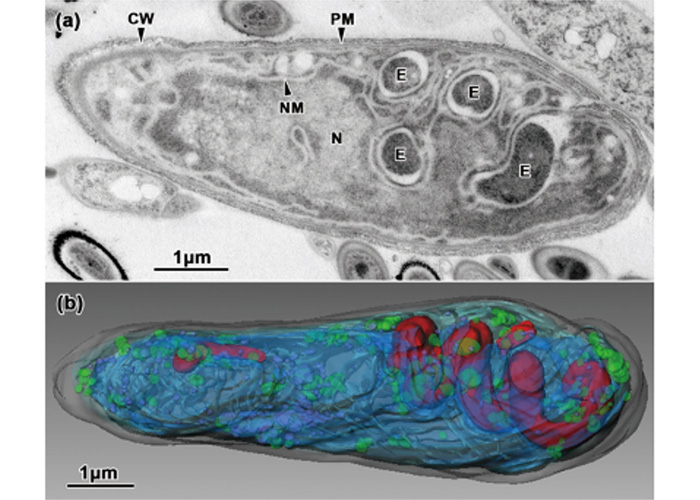応用事例
イメージング関連製品:
深海からのユニークな微生物
論文紹介:深海からのユニークな微生物
Prokaryote or eukaryote? A unique microorganism from the deep sea
- 著者(太字は当社メンバー)
Masashi Yamaguchi1*, Yuko Mori2, Yoshimichi Kozuka3, Hitoshi Okada1,4, Katsuyuki Uematsu5, Akihiro Tame5, Hiromitsu Furukawa2, Tadashi Maruyama6, Cedric O’Driscoll Worman7 and Koji Yokoyama1
1Medical Mycology Research Center, Chiba University, 2System in Frontier Inc., 3Vacuum Device Co. Ltd., 4Integrated Imaging Research, 5Marine Works, 6Marine Biodiversity Research Program, Japan Agency for Marine-Earth Science and Technology, 7Department of Biology, Francis Marion University
- 掲載誌
- Journal of Electron Microscopy, Volume 61, Issue 6, December 2012, Pages 423‒431,
https://doi.org/10.1093/jmicro/dfs062
- Abstract
- There are only two kinds of organisms on the Earth: prokaryotes and eukaryotes. Although eukaryotes are considered to have evolved from prokaryotes, there were no previously known intermediate forms
between them. The differences in their cellular structures are so vast that the problem of how eukaryotes could have evolved from prokaryotes is one of the greatest enigmas in biology. Here, we report a unique organism with cellular structures appearing to have intermediate features between prokaryotes and eukaryotes, which was discovered in the deep sea
off the coast of Japan using electron microscopy and structome analysis. The organism was 10 μm long and 3 μm in diameter, having >100 times the volume of Escherichia coli. It had a large ‘nucleoid’, consisting of naked DNA fibers, with a single nucleoid membrane and endosymbionts that resemble bacteria, but no mitochondria. Because this organism appears to be a life form distinct from both prokaryotes and eukaryotes but similar to eukaryotes, we named this unique microorganism the ‘Myojin parakaryote’ with the scientific name of Parakaryon myojinensis (‘next to (eu)karyote from Myojin’) after the discovery location and its intermediate morphology. The existence of this organism is an indication of a potential evolutionary path between prokaryotes and eukaryotes.
- 解説
- 地球上のすべての生物は核をもたない原核生物と核を持つ真核生物に分類されますが、原核生物から真核生物に変化(進化)した過程については、まだ謎とされています。千葉大学の真菌医学研究センター(当時)の山口正視博士は、海洋研究開発機構の研究船が伊豆・小笠原諸島の明神海丘の海域、水深1,200mn海底で採取したサンプルを透過型電子顕微鏡でくまなく観察して、原核生物と真核生物の中間的構造をもつ生物(細胞)を見つけることに成功、これを准核生物・パラカリオン・ミョウジネンシスと名付けました。
このパラカリオン・ミョウジネンシス(体長7-8ミクロン)の特異な構造を明らかにするために、当社の森裕子さんが、自身が開発したアプリケーションソフトウエア Stack N Vizを使って、電子顕微鏡像から細胞の三次元構造を再構成してCG化を行いました。

(b) 当社のアプリケーションで三次元再構成した結果
他にも千葉大学・真菌医学研究センターの山口博士との共同研究においては以下の論文も発表されています。
- タイトル
- High-voltage electron microscopy tomography and structome analysis of unique spiral bacteria from the deep sea
- 著者:(太字は当社メンバー)
Masashi Yamaguchi, Hiroyuki Yamada, Kimitaka Higuchi, Yuta Yamamoto, Shigeo Arai, Kazuyoshi Murata, Yuko Mori, Hiromitsu Furukawa, Mohammad Shorif Uddin, and Hiroji Chibana
- 掲載誌
Microscopy, 2016, 1‒7
https://doi.org/10.1093/jmicro/dfw016
- タイトル
- Good Ultrastructural Preservation of Human Tissues and Cultured Cells by Glutaraldehyde Fixation, Sandwich Freezing, and Freeze-Substitution
- 著者:(太字は当社メンバー)
Masashi Yamaguchi, Seiichiro Wakabayashi, Yuumi Nakamura, Hiroyuki Matsue, Takuya Hirao, Shigeki Aoki, Shohei Yamashina, Hiroyuki Yamad, Nobuya Mamizu, Hiromitsu Furukawa and Hiroji Chibana
- 掲載誌
Cytologia 2020 85(1): 15-26
https://doi.org/10.1508/cytologia.85.15


